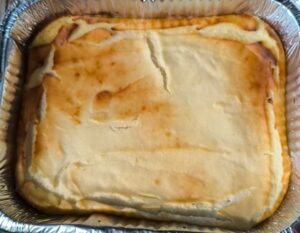Polenta. Mamaliga. Mieliepap. Kachamak.
 |
| Store bought polenta chub. |
These are just but a few of the many, many, many names out there for corn meal “mush”, used as a starch all over the world. The most famous name of all of these is polenta, which is how I’ll be referring to it throughout this post.
Polenta was eaten by the Italian poor for centuries, and as I am quite fond of Italian traditional foods, not to mention any types of gluten free filling starches to add variety to my diet, I knew polenta was going to be something that I’d start to make often.
Let me explain something that I never knew about polenta. Polenta starts off like a porridge, but as it cools down, it becomes hard enough that you can slice it and use it as you would noodles, as well as many other uses. (I’ll elaborate on that later.) Ready made polenta chubs are sold in grocery stores to be used in all sorts of recipes.
But you know me.
I don’t buy anything ready made if I can possibly make it myself, from scratch.
Can polenta be made from scratch?
Absolutely. Its pretty much one of the easiest make from scratch foods that I make.
And dirt cheap. Which is why poor people throughout the globe ate it. Which makes it a terrific meal base for someone as extremely frugal as myself.
Here’s how to make it.
Perfect Polenta Recipe
Ingredients
1 cup cornmeal
3 cups water, milk, or broth
Salt
Spices as desired (I like to add garlic powder, onion flakes, and Italian herbs like oregano and basil)
Instructions
1. Mix the corn meal, liquid, salt, and spices in a pot.
 |
| I know, it looks like that ratio of water to corn meal could never make anything remotely solid enough to slice, but believe me, it does. |
2. Bring to a boil, mixing constantly.
3. Cook until it starts to thicken somewhat. This is stage one.
 |
| Starting to thicken. Notice the difference between the thickness in this picture and the next one. |
4. Cook until it gets even thicker. If you stop mixing this for a few seconds now, you should have big bubbles popping in the porridge, making loud noises. The consistency should be somewhat thicker than cream of wheat, but still rather porridge like.
 |
| See the bubbles? It was bubbling like crazy, and was so hard to take a picture because I was worried about the bubbles popping and splattering polenta onto my nice camera. |
 |
| Here’s a better look at the finished polenta. Note the thickness. It isn’t as thick as mashed potatoes, and is just a touch less runny than cream of wheat. Don’t worry, this will thicken just fine! |
 |
| Polenta in my silicon baking dish. I don’t care about looks so much, I care more about taste and ease, so I prefer using a dish I don’t have to line. |
6. Refrigerate your polenta for at least 3 hours. It should harden considerably, and have a consistency sort of like… hrmm, its hard to describe. I want to describe it as being as hard as meunster cheese. Meaning, it’s nice and solid and can be sliced with a knife, but it has some give to it.
 |
| The solidified polenta. Sometimes it solidifies so much that it cracks like it did in this picture. |
7. Slice your polenta and use it in many ways.
- Use it as a base for sauce and other toppings as you would a plate of spaghetti or drop biscuits. (Tomato sauce, cheese, gravy, etc…)
- Brush it with oil and bake it to give it a nice, crispy topping and creaming center.
- Make it into lasagna, putting layers of polenta, then sauce, then fillings.
- Grill it.
- Fry it. (I’ll write details about how to do this in another post as it’s not as simple as it sounds.)




